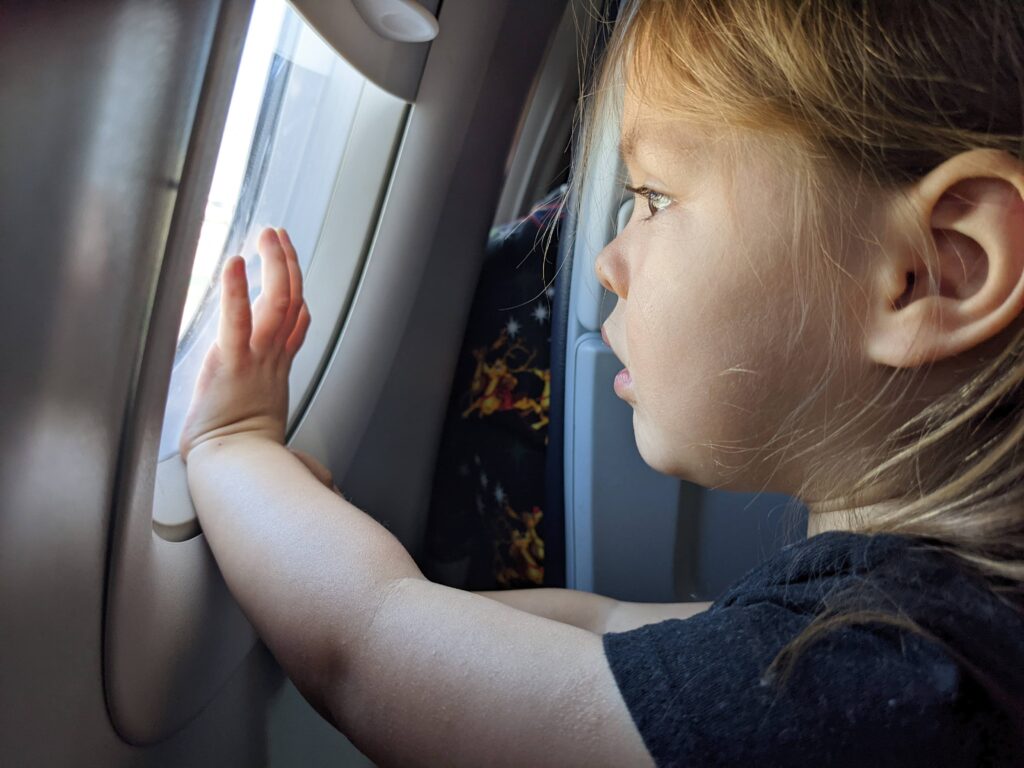Back in my twenties, I saved $50,000 with my (now ex) husband and spent 18 months traveling around the world as budget-minded (but not bare-bones) backpackers. We stayed in guesthouses, took overnight buses, splurged occasionally, and stretched our savings across 40+ countries. That trip taught me more about money, priorities, and freedom than any job ever could. (And also was how Dani and I met and fell in love, read more about that here.)
Dani also has spent time on long-term travel, and lived abroad. As a couple, we balanced traveling with growing our careers.
Now, as parents of two, we still travel often—but our savings strategy has evolved. The truth? You don’t need to be rich, just intentional.
In this post, I’ll share exactly how we used to save for long-term travel, and the real-life habits we use now as a family of four—plus how we approach credit cards, budgeting, and points programs without turning it into a full-time job.
✨ Want a copy of the actual spreadsheet I used to plan and budget my round-the-world trip? Send me a DM on Instagram and let me know, I could make it into a template if people are interested.
How to Save Money for Travel: Practical Habits That Actually Work
Money = life energy
When we first started saving for traveling with kids, we weren’t clipping coupons or cutting out every luxury. We just got really intentional. And one of the biggest mindset shifts we made was this:
💡 Money is stored life energy.
Every dollar you spend today is an hour (or more) of your time tomorrow.
This idea comes from a book I read in 2018 called Your Money or Your Life by Vicki Robin and Joe Dominguez, and it completely reframed how I looked at spending. Instead of thinking in dollars, I started thinking in trade-offs. $75 for a concert? That’s might be a week of accommodation in Vietnam. A $30 Uber? That’s a full day’s food budget in Bali
Every dollar you spend represents time from your life that you traded away to earn it. That latte isn’t $6—it’s 20 minutes of your life. That $150 impulse Target run? That might be an entire workday.
This framework helped me move from “Can I afford it?” to “Is this worth trading my life for?” And once you start looking at purchases that way, it becomes much easier to say no to things you don’t truly value—like subscriptions you forgot about or trendy gadgets you’ll barely use.
How to Calculate Your Real Hourly Rate
Even if you’re salaried or work irregular hours, it’s still possible—and useful—to figure out how much of your time each dollar costs you.
Here’s how:
- Start with your monthly income (after taxes).
Let’s say you bring home $4,000/month. - Estimate your average hours spent working—including commute time, emails after hours, even that recovery “crash” time on Friday night.
If that’s 45 hours/week x 4 = 180 hours/month. - Divide your income by your hours.
$4,000 ÷ 180 = $22.22/hour
But wait—Your Money or Your Life takes it further. You also subtract work-related costs like:
- Gas or transit passes
- Office clothes or dry cleaning
- Takeout lunches
- Childcare
- Stress-induced “treat yourself” spending
If those add up to $600/month, your real income is $3,400. So:
$3,400 ÷ 180 = $18.89/hour
This is the number that matters.
When you’re about to buy something—especially something impulsive or non-essential—ask yourself:
👉 “How many hours of my life is this worth?”
It might be:
- A new $120 outfit = 6 hours of your life
- A $40 dinner = 2 hours
- A $10/month app = 6 hours/year
Some things will still be worth it. But now you’ll know—and you’ll start redirecting a surprising amount of spending toward things that actually align with your goals, like… saving for a trip.
Create a Simple Budget That Prioritizes Travel
You don’t need a complicated system. I started tracking our expenses every month with a Google Sheets spreadsheet that I created, and reviewed each category to ask: “Could this have been travel?” It was eye-opening.
For example:
- One fancy date night = 2 days of street food and museums in Mexico City
- Monthly subscription boxes = train travel across Japan
- Impulse Amazon purchases = a flight deal to Portugal
Once you see your spending through the lens of “travel instead,” it gets easier to say no to stuff and yes to experiences.
👉 Want to see the exact budget spreadsheet I use every month? Send me a DM on Instagram and let me know, I could make it into a template if people are interested.
How to Save Money for Travel as a Family of Four
Fast forward to now: two kids, a mortgage, preschool tuition, and a lot more logistics. But the core principle hasn’t changed. We still prioritize travel—we just save differently.
Automate Your Travel Fund
One of the smartest things we’ve done (thanks to our financial advisor!) is set up a weekly automatic transfer into a separate checking account. It’s at a different bank, so we don’t see it every time we log into our main accounts—and we never touch it until we’re booking a flight, accommodation, or paying for a rental car.
This strategy does two things:
- Flattens the cost curve so we’re not scrambling before big trips
- Makes travel feel like a monthly expense that is important to our family, not an optional luxury
Set Specific Savings Goals
We usually plan a big trip 6 months to a year out. And because half our family is in Australia, the flights are usually the biggest expense. If we know a trip will cost $8,000, we divide that by 52 weeks and aim to set aside $155 per week. That gives us a clear benchmark and helps with decision-making in the moment.
Here’s a tip that makes it feel more fun:
💸 Whenever you choose a cheaper option—say, a food truck over a fancy dinner—transfer the savings right then. You’ve already “spent” that money mentally. Now move it into your travel fund. We’ve saved hundreds this way, one small decision at a time.
How We Use Rewards Points to Save Money on Travel (Without Going Full Travel Hacker)
Let’s talk points.
Travel hacking is huge in the blogging world—there are entire YouTube channels and Reddit threads dedicated to maximizing every single dollar spent. But to be honest? I don’t have the time or energy to chase obscure bonuses or rotate through 10 different cards.
Still, I’ve found a simple, sustainable system that works—and helps us save real money on flights, hotels, and car rentals without it feeling like a second job.
1. Use One Travel Rewards Card for (Almost) Everything
We put nearly every expense—groceries, bills, even daycare when we can—on a single rewards credit card and pay it off in full each month. That last part is critical. Travel points are worthless if you’re racking up interest.
Right now, we use the Amex Delta Reserve card, and yes, we do pay the high annual fee—because once you’ve had airport lounge access with kids, it’s hard to go back. (Nothing says vacation like a glass of champagne before take-off no matter the time of day.)
When we lived in a United hub city, we used the Chase United Explorer card instead. (referral link, includes a bonus for both of us). My advice? Don’t overthink the brand or calcuate the cents per point for all of them (it changes all the time). Pick an airline you’re likely to fly and start earning miles from your everyday spending.
💡 We don’t chase spending thresholds for bonus points or open multiple cards a year—it’s just not worth the stress for us.
2. Sign Up for Every Rewards Program
Whenever we book a flight, hotel, or rental car we sign up for the rewards program if we don’t already have one. Even if we only use it once or twice, those points add up slowly over time. Plus, for things like rental cars, signing up often gets you access to a priority check-in line, which can save you a lot of time after a long travel day with kids.
And here’s a small travel hack that works for us:
When I book a hotel through a rewards site that allows it, I set my points to automatically transfer to Delta. That way, all my points accumulate in one place, and I don’t have a bunch of random balances floating around in different systems.
I’m not loyal to any one rental company, but I will say Hertz’s Gold Members line tends to be less painful—worth signing up since it’s free.
3. Stack Cashback with Rakuten
This isn’t a travel card thing, but it’s my favorite passive way to save money for travel while buying the things we already need.
I use Rakuten for online shopping whenever possible. It’s a free browser extension that gives you cash back—like, actual cash to my Paypal account, not points—on purchases at thousands of stores. Think Target, Walmart, Expedia, and more.
Every quarter, I get between $10 and $60 deposited straight into my PayPal. No hoops to jump through, no need to redeem anything. Just easy, no-brainer travel savings.
Final Thoughts: Saving for Travel Is About Intention, Not Sacrifice
At the end of the day, learning how to save money for travel isn’t just about cutting lattes or chasing every last point—it’s about aligning your everyday choices with the life you actually want.
Whether you’re dreaming of a family road trip, a summer abroad, or a year-long adventure around the world, the key is to start now. Create a simple budget, automate your savings, and take advantage of the tools—like rewards points and cash-back apps—that work for your lifestyle.
Traveling as a family doesn’t have to feel out of reach. We’ve done it on a shoestring in our 20s and are still doing it now with two kids and a mortgage. The difference isn’t in the income—it’s in the mindset, the systems, and the priorities.
✨ Ready to plan your own bold adventure?
Learn more about my free travel budget + itinerary spreadsheet, or check out our AI-powered family trip planner to make the most of every dollar you save.




